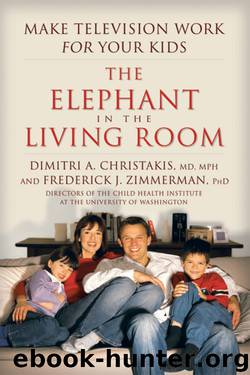The Elephant In the Living Room by Dimitri A. Christakis & Frederick J. Zimmerman

Author:Dimitri A. Christakis & Frederick J. Zimmerman
Language: eng
Format: epub
Publisher: Potter/Ten Speed/Harmony/Rodale
Published: 2013-05-15T04:00:00+00:00
TV AND FOOD CHOICES
When Ray Kroc, a Multimixer salesman, set out from Oak Park, Illinois, to visit a hamburger stand in San Bernardino, California, in 1954, he was interested in selling mixers, not in making U.S. children obese. Intrigued by the number of mixers Dick and Mac McDonald were buying, Kroc decided to visit their hamburger franchise personally to learn more about it. Quickly realizing that the growth of their enterprise would enhance sales of his product, he became very invested in their success—so much so that he took over the company himself in 1961.
Twenty-seven years later, Fortune magazine named McDonald’s hamburgers among the 100 products America makes best. By all accounts, the rise of McDonald’s from a small local hamburger stand to an international icon is a quintessential American success story. Although it’s now frequently maligned as a major contributor to the rise in childhood obesity, until very recently, McDonald’s success was heralded. U.S. Secretary of Agriculture Charles Murphy ate the 500 millionth McDonald’s hamburger in a public ceremony in 1961. In 1963, the billionth hamburger was served by Ray Kroc on Art Linkletter’s nationally televised show. And in 1990, Life magazine named Ray Kroc as one of the “100 most important Americans of the 20th century.”
McDonald’s meteoric rise in sales owes much to the success of its advertising campaigns, which remain the envy of many in the industry and a source of more than a few earworm jingles for the rest of us. In 2000, Advertising Age reviewed and ranked the most successful campaigns of all time. The 1971 McDonald’s campaign, “You deserve a break today,” was ranked number five. The jingle that accompanied the ads (can you hum it now?) was rated number one, ahead of the army’s “Be all that you can be” and Campbell’s soup’s “M’m M’m good.” Ronald McDonald was second only to the Marlboro man as an ad icon. He’s credited with bringing fast food to children in the same way the rugged cowboy brought cigarettes to adults (and children).
These televised icons and advertisements and their accompanying jingles are problematic. People who watch a lot of television are more likely to rate unhealthy foods as “good for you.”27 More than half of 9- to 10-year-old Australian children believe that Ronald McDonald knows best what’s good for children to eat, and television is where they grew to trust him. As much as 40 percent of McDonald’s advertising—the overwhelming majority of which is televised—is directed at children. In 1965, the company’s sales were $200 million; today, they exceed $37 billion. Sales began to take off in 1970 and have risen steadily ever since. Notably, that year was also when McDonaldland became the setting for a new series of advertisements directed at children, and in 1977, the Happy Meal was introduced. The meteoric rise in sales began when children became a major focus of the franchise business model. Coincidence?
Download
This site does not store any files on its server. We only index and link to content provided by other sites. Please contact the content providers to delete copyright contents if any and email us, we'll remove relevant links or contents immediately.
Letter to My Daughter by Maya Angelou(1766)
Dog Training 101 by Kyra Sundance(1560)
The Pizza Party by Theo Baker(1467)
The Whole Lesbian Sex Book by Felice Newman(1427)
The Unofficial Guide to Walt Disney World with Kids 2017 by Bob Sehlinger(1256)
Art Lab for Little Kids (Lab Series) by Susan Schwake(1249)
An XL Life by Big Boy(1145)
Talking with Your Toddler by Teresa Laikko(1125)
The Budding Chef by Kate Kuhn(1114)
Playful Parenting by Cohen Lawrence J(1106)
Encyclopedia of Infant and Toddler Activities by Kathy Charner(1100)
Zen Mind, Beginners Mind by Shunryu Suzuki(1097)
Circus by unknow(1091)
Welding for Dummies by Welding(1071)
Photographing Families by Unknown(1056)
The Big Book of Nature Activities by Jacob Rodenburg(1038)
The Creative Family Manifesto by Amanda Blake Soule(997)
The Sense of Wonder by Rachel Carson(989)
Ruby Ridge(948)
